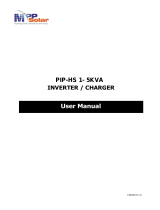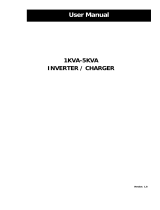
1
1. General Information
1.1 Overview
Offgridtec IC-Series is a new energy storage inverter/charger that integrates utility charging, solar charging,
and AC output. The high-performance multi-core chip in the product with the advanced control algorithm
brings intelligent management of the system.
As a reliable industrial standard equipment, IC has quick response speed and excellent high transfer efficiency.
Intelligent adjustment of total charging current from both solar and utility, automatic adjustment is realized
via different working modes selection, which ensures to provide power energy supply maximally.
The PV charging module adopts the up-to-date optimized MPPT tracking technology; it can quickly track the
PV array's maximum power point in any environment. The MPPT tracking speed and energy transfer
efficiency are quite high. The PV and AC charge current can be adjusted manually, which can meet the total
charge current limit function. PV & utility charge current ratio distribution. Full electronic protection
functions are available.
With a fully digital double closed-loop control, the AC-DC charging unit has extremely high response speed
and stability. A wide AC input voltage and charge current limitation can be set. This module has complete
protection functions at input and output.
The DC-AC inverter module is based on full digital and intelligent design. It adopts the advanced SPWM
technology, outputs the pure sine wave, and converts 24/48VDC to 220/230VAC, suitable for AC loads of
household appliances, electric tools, commercial units, electronic audio, and video devices, etc.
With the Utility by-pass charging function, the utility module can provide a power supply to load directly and
charge the battery simultaneously. Under utility charge status, the user can choose by-pass mode or inverter
output mode. I-series provides multiple power supply modes, such as solar and utility, to maximize the use
of green energy while ensuring electricity supply.
The display module is key for communication. The 4.2 inch LCD presents system status and real-time data;
the user can set work parameters easily by four buttons.
Features:
Full intelligent digital energy storage equipment
Adjustment function of Utility & Solar charging ratio to meet various applications
Advanced MPPT tracking technology, Max. tracking efficiency 99.5 %, Max. conversion efficiency 98.5 %
Advanced all-digital control AC-DC charging modules to realize wide voltage input, high efficiency, and high
stability
Advanced SPWM technology to ensure maximum efficiency up to 95 %, and full load efficiency up to 93 %
High output voltage stability: when full load working in the working voltage range of battery, output
voltage
220V/230V±5%①, frequency 50/60±0.1 Hz; voltage& frequency optional
Advanced voltage, current, and power multi-loop control makes the DC-AC unit has good dynamic
response capability, high resistance to surge power, and high operational reliability
With the function of Utility & Solar charging ratio selection, and total charging current setting
Four charging modes: Utility priority, Solar priority, Utility & Solar and Solar only
Two output modes: Battery and Utility
Utility charging and inverter output can work at the same time, which avoids the impact of the unstable
























